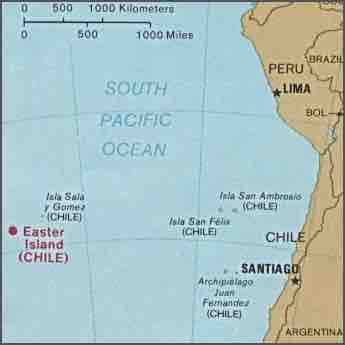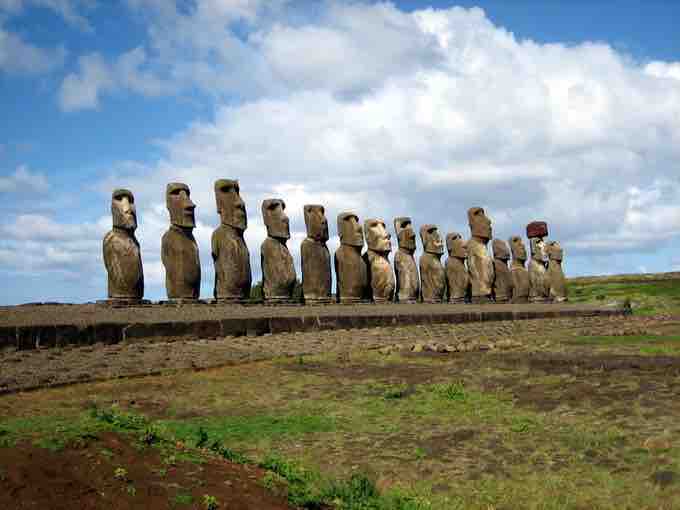Background: Easter Island
Easter Island is a Polynesian island in the southeastern Pacific Ocean, located at the southeasternmost point of the Polynesian Triangle. A special territory of Chile that was annexed in 1888, Easter Island is famous for its 887 extant monumental statues, called moai, created by the early Rapa Nui people. It is a UNESCO World Heritage Site, with much of the island protected within Rapa Nui National Park. In recent times, the island has served as a warning of the cultural and environmental dangers of exploitation. Ethnographers and archaeologists also blame diseases carried by European sailors and Peruvian slave raiding of the 1860s for devastating the local peoples.

Easter Island and the islands near South America.
Easter Island is a Polynesian island in the southeastern Pacific Ocean, at the southeasternmost point of the Polynesian Triangle.
Stone Work
The Rapa Nui people had a Stone Age culture that made extensive use of several different types of local stone, including basalt, obsidian, red scoria, and tuff. The large stone statues for which Easter Island is world-famous, known as moai, were carved from 1100–1680 CE. A total of 887 monolithic stone statues have been inventoried on the island and in museum collections so far. Although often identified as "Easter Island heads", most of the statues have torsos and end at the top of the thighs, and a small number are complete with the figures kneeling on bent knees and their hands over their stomachs. Almost all moai (roughly 95%) were carved out of distinctive, compressed, and easily worked solidified volcanic ash or tuff found at a single site inside the extinct volcano Rano Raraku. The native islanders who carved them used only stone hand chisels; while many teams worked on different statues at the same time, a single moai took a team of five or six men approximately one year to complete. Each statue represented the deceased head of a lineage.
The Rapa Nui are also know for their construction of ahu, or stone platforms, many of which (approximately 125 of the 313 known ahu) carry moai. Ahu Tongariki, one kilometer from Rano Raraku, had the most and tallest moai of any of the ahu. These stone platforms evolved from the traditional Polynesian marae. In this context, ahu referred to a small structure sometimes covered with a thatched roof where sacred objects, including statues, were stored. The ahu were usually adjacent to the marae, or main central court where ceremonies took place. On Easter Island, both ahu and moai evolved to a much greater size. Ahu are found mostly on the coast, where they are distributed fairly evenly, except on the western slopes of Mount Terevaka and the Rano Kau and Poike headlands.

Ahu Tongariki near Rano Raraku
Ahu Tongariki is a 15-moai ahu that was excavated and restored in the 1990s.
One of the highest-quality examples of Easter Island stone masonry is the rear wall of the ahu at Vinapu. Made without mortar by shaping hard basalt rocks of up to seven tons to match each other exactly, it has a superficial similarity to some Inca stone walls in South America.
Houses of the Rapa Nui
Two types of houses are known to have existed in Easter Island History: hare paenga, a house with an elliptical foundation made with basalt slabs and covered with a thatched roof that resembled an overturned boat, and hare oka, a round stone structure. Related stone structures called tupa look very similar to the hare oka, except that the tupa were inhabited by astronomer-priests and located near the coast, where the movements of the stars could be easily observed. Settlements also contain hare moa, or oblong stone structures that were used to house chickens. The houses at the ceremonial village of Orongo are unique in that they are shaped like hare paenga but are made entirely of flat basalt slabs found inside Rano Kao crater. The entrances to all the houses are very low, requiring a person to crawl in order to enter.
Petroglyphs
Easter Island has one of the richest collections of petroglyphs in all Polynesia, with over 4,000 petroglyphs cataloged. Designs and images were carved out of rock for a variety of reasons, including to create totems, to mark territory, or to memorialize a person or event. There are distinct variations around the island in terms of the frequency and particular themes among petroglyphs, with a concentration of Birdmen at Orongo. Other subjects include sea turtles, Komari (vulvas) and Makemake, the chief god of the Tangata manu or Birdman cult.
Rongorongo
Easter Island once had an apparent script called rongorongo. Glyphs include pictographic and geometric shapes; the texts were incised in wood in reverse boustrophedon direction. It was first reported by a French missionary, Eugène Eyraud, in 1864. At that time, several islanders said they could understand the writing, but according to tradition, only ruling families and priests were ever literate, and none survived the slave raids and subsequent epidemics. Despite numerous attempts, the surviving texts have not been deciphered, and without decipherment it is not certain that they are actually writing.